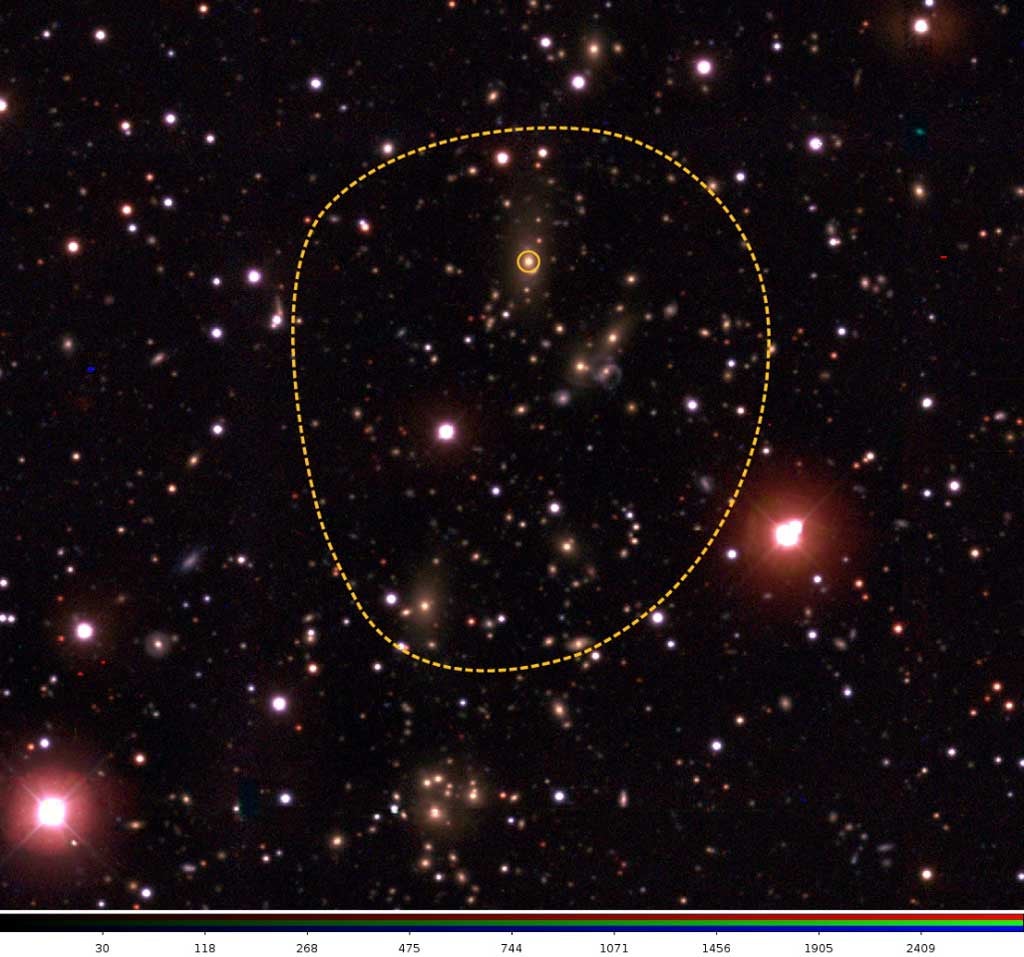Astronomers have known for more than 80 years that our universe is expanding from an event called the Big Bang. In 2011, the Nobel Prize in physics was awarded for the even more exciting discovery that the rate of expansion is increasing, rather than slowing down as might be expected. The cause of this acceleration, referred to as dark energy, is not understood.
“By looking at galaxy clusters at different epochs in cosmic history, astronomers can explore whether dark energy has acted differently at different times in the history of the universe,” said Jeeseon Song from the University of Michigan, Ann Arbor. “Galaxies, including our own Milky Way Galaxy, are vast assemblages of stars and gas. Clusters of galaxies, conglomerates of tens to hundreds of galaxies, are the largest structures in the universe. They are dynamically changing and aging over time, and that is very crucial in cosmological studies because that’s where we can see how dark energy is acting on the universe, pulling the clusters apart.” By studying the distribution of clusters at different times in the past, astronomers detect what dark energy does to the universe, allowing them to figure out what dark energy is.
The team has identified an important sample of galaxy clusters whose distances have been determined accurately enough to study how the density of galaxy clusters varies with the age of the universe. To do this, they began with observations from the South Pole Telescope, a millimeter-wavelength survey telescope. Crucial follow-up work at the Blanco Telescope 4-meter at Cerro Tololo Inter-American Observatory in Chile enabled them to refine cluster distances to within a few percent. The Blanco Telescope celebrates its 50th anniversary this year, but with modern instrumentation such as the Mosaic camera used in this study, it still plays a vital role in cutting-edge research.
It has been known for decades that in the expanding universe the farther away an object is, the faster it is receding from us. Measuring velocity is based on an effect seen in everyday life: As an object moves farther away, its light shifts to longer, or redder, wavelengths — called redshift. As an object moves closer, the light wavelengths shorten, shifting to blue. This Doppler shift of light waves is used by highway patrols to measure the velocity of cars on the highway.
Because of the expansion of the universe, objects with large redshifts are not only far away, but also are observed as they were a long time in the past. The galaxy clusters in this study have an average redshift of about 0.6. At this redshift, the universe was only about half of its present age of 13.7 billion years. But the clusters span a range in distance from those close enough to be seen almost as they are in the present universe, to some with redshift as large as 1.4, which means we see them as they appeared when the universe was less than a third of its present age.
Astronomers have known for more than 80 years that our universe is expanding from an event called the Big Bang. In 2011, the Nobel Prize in physics was awarded for the even more exciting discovery that the rate of expansion is increasing, rather than slowing down as might be expected. The cause of this acceleration, referred to as dark energy, is not understood.
“By looking at galaxy clusters at different epochs in cosmic history, astronomers can explore whether dark energy has acted differently at different times in the history of the universe,” said Jeeseon Song from the University of Michigan, Ann Arbor. “Galaxies, including our own Milky Way Galaxy, are vast assemblages of stars and gas. Clusters of galaxies, conglomerates of tens to hundreds of galaxies, are the largest structures in the universe. They are dynamically changing and aging over time, and that is very crucial in cosmological studies because that’s where we can see how dark energy is acting on the universe, pulling the clusters apart.” By studying the distribution of clusters at different times in the past, astronomers detect what dark energy does to the universe, allowing them to figure out what dark energy is.
The team has identified an important sample of galaxy clusters whose distances have been determined accurately enough to study how the density of galaxy clusters varies with the age of the universe. To do this, they began with observations from the South Pole Telescope, a millimeter-wavelength survey telescope. Crucial follow-up work at the Blanco Telescope 4-meter at Cerro Tololo Inter-American Observatory in Chile enabled them to refine cluster distances to within a few percent. The Blanco Telescope celebrates its 50th anniversary this year, but with modern instrumentation such as the Mosaic camera used in this study, it still plays a vital role in cutting-edge research.
It has been known for decades that in the expanding universe the farther away an object is, the faster it is receding from us. Measuring velocity is based on an effect seen in everyday life: As an object moves farther away, its light shifts to longer, or redder, wavelengths — called redshift. As an object moves closer, the light wavelengths shorten, shifting to blue. This Doppler shift of light waves is used by highway patrols to measure the velocity of cars on the highway.
Because of the expansion of the universe, objects with large redshifts are not only far away, but also are observed as they were a long time in the past. The galaxy clusters in this study have an average redshift of about 0.6. At this redshift, the universe was only about half of its present age of 13.7 billion years. But the clusters span a range in distance from those close enough to be seen almost as they are in the present universe, to some with redshift as large as 1.4, which means we see them as they appeared when the universe was less than a third of its present age.










